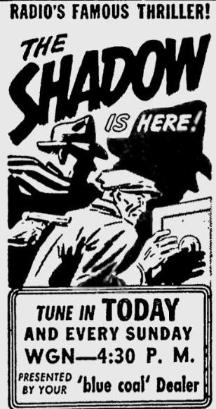
 Who knows what evil lurks in the hearts of men? The Shadow knows!
Who knows what evil lurks in the hearts of men? The Shadow knows!
The Shadow (1937-1954) aired “The Gorilla Man” on April 21, 1946. It has been almost six months since the last The Shadow episode, so it is high time for another. As I have done before and for the benefit of new listeners to The Shadow, I’d like to provide some background history on how the Shadow came to be, both in print and on radio. Long time listeners will have read this before, but for new listeners this background will prove informative.
The history of the Shadow character is long and storied. A bare bones synopsis begins on July 3, 1930 when the narrator of magazine publisher Street & Smith’s radio version of its pulp magazine, Detective Story Magazine, was given the name of The Shadow. This mysterious voice who merely introduced and narrated the radio show, but was not a character in any of the episodes, became so popular after it was taken over by Frank Readick, Jr. and his spooky, phantom laugh that on April 1, 1931 The Shadow magazine was born. It ran for 325 issues, 282 of them written by Walter B. Gibson (1897-1985) under the house name of Maxwell Grant.
The Shadow debuted on radio on September 26, 1937 and delighted fans for more than seventeen years, closing shop on December 26, 1954. The radio show began its long run on the Mutual Broadcasting Network on Sunday evenings and was sponsored by Blue Coal. From its inception until just past its first year (Sept., 1937-Oct., 1938) the voice of the young 22-year-old Orson Welles (1915-1985) would be heard as that of The Shadow, and Agnes Moorehead (1900-1974) would play the role of “the lovely Margot Lane,” his “faithful companion” and aide. Following Welles’s departure Bill Johnstone became The Shadow. Johnstone was then succeeded by Bret Morrison (1912-1978, photo top right), who, in two stints (1943-44 & 1945-54), was radio’s The Shadow for ten of its seventeen years (though others besides these three mainstays would ascend to the role). Moorehead would also exit the show (in 1940) to follow Welles after he formed his Mercury Theater on the Air, as well as appear in several of the young genius’s classic films.
To arrest possible confusion arising from seeming inconsistencies between the print and radio versions of The Shadow it is important to note the following differences (though there are others):
The original print version of the Shadow portrayed him without any powers at all; he was a shadowy figure of the darkness, a cunning sleuth dedicated to overthrowing evil wherever he found it. It wasn’t until the radio version came along that he was imbued “with the power to cloud men’s minds” from a secret he learned in the Orient.
In The Shadow novels, Miss Lane’s first name was spelled Margo; for radio it was Margot.
In The Shadow novels, Margo Lane was not aware of the Shadow’s secret identity; for the radio scripts she was the only one who did know his secret identity.
In the magazine, the Shadow’s primary alter-ego was (eventually) revealed as that of Kent Allard; his radio alter-ego was Lamont Cranston.
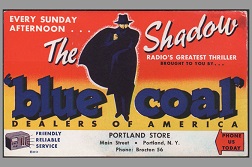 However, the major change between the magazine and radio versions–and that which would throw longtime fans into a furor of complaint and outrage in the letter column of the magazine–occurred when Margot Lane was introduced in the very first radio episode as the Shadow’s companion, love-interest, and aide. For you see, since the magazine’s inception in 1931 there had never been a female companion/aide for the Shadow. Margo Lane was not introduced into the pages of the magazine until 1941, four years after her debut on the first radio episode. There is also a definite difference in the level of intimacy depicted between Margo/Allard (the magazine) and Margot/Cranston (radio). The later magazine relationship was less romantic and decidedly more platonic than that of the radio episodes, which were, in any case, almost as pure as the wind-driven snow by today’s standards. Perhaps this distancing of the “romantic” interest in the magazine was to assuage longtime readers outraged at Lane’s insertion into the radio episodes in the first place, and then later in “their” magazine years later. (In short, longtime readers resented the new addition to the radio episodes and then the magazine, while those coming to the radio version first, and liking the interplay between Margot and Cranston, wanted to see her in the magazine as well.) Whatever the reason, the radio relationship was originally conceived and patterned on that of the highly popular Thin Man movies of the time, starring William Powell and Myrna Loy as Nick and Nora Charles.
However, the major change between the magazine and radio versions–and that which would throw longtime fans into a furor of complaint and outrage in the letter column of the magazine–occurred when Margot Lane was introduced in the very first radio episode as the Shadow’s companion, love-interest, and aide. For you see, since the magazine’s inception in 1931 there had never been a female companion/aide for the Shadow. Margo Lane was not introduced into the pages of the magazine until 1941, four years after her debut on the first radio episode. There is also a definite difference in the level of intimacy depicted between Margo/Allard (the magazine) and Margot/Cranston (radio). The later magazine relationship was less romantic and decidedly more platonic than that of the radio episodes, which were, in any case, almost as pure as the wind-driven snow by today’s standards. Perhaps this distancing of the “romantic” interest in the magazine was to assuage longtime readers outraged at Lane’s insertion into the radio episodes in the first place, and then later in “their” magazine years later. (In short, longtime readers resented the new addition to the radio episodes and then the magazine, while those coming to the radio version first, and liking the interplay between Margot and Cranston, wanted to see her in the magazine as well.) Whatever the reason, the radio relationship was originally conceived and patterned on that of the highly popular Thin Man movies of the time, starring William Powell and Myrna Loy as Nick and Nora Charles.
Another major difference between the magazine and radio versions was adopted because of the medium of radio itself. Realizing that it could become difficult to keep more than a few characters separate by voice only, we do not find the print version’s large supporting cast who clandestinely aide the Shadow in his crime-fighting adventures.
The opening lines of every Shadow episode are some of the most famous in the world: Who knows what evil lurks in the hearts of men? The Shadow knows! Not quite so well-remembered, however, but just as iconic among Shadow fans is the cautionary tag-line, directed especially at children: The weed of crime bears bitter fruit. Crime does not pay. The Shadow knows!
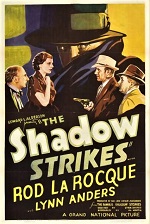 The (radio) Shadow is without superpowers in the traditional sense, relying only on his intellect and his strange power to “cloud men’s minds” so that they cannot see him. This “magical” ability was learned while visiting various lands in the Orient. The Shadow is a super-sleuth, a dark crime-fighter whose secret identity is his greatest weapon in fighting crime and injustice of all kinds. Unfortunately, his methods are ofttimes not strictly inside the letter of the law, and thus he is regarded as a criminal by the police–the very people he is trying to help. The character of The Shadow has been acknowledged and verified as, without question, the inspiration and prototype for several notable fictional characters, the most popular of which is none other than Batman.
The (radio) Shadow is without superpowers in the traditional sense, relying only on his intellect and his strange power to “cloud men’s minds” so that they cannot see him. This “magical” ability was learned while visiting various lands in the Orient. The Shadow is a super-sleuth, a dark crime-fighter whose secret identity is his greatest weapon in fighting crime and injustice of all kinds. Unfortunately, his methods are ofttimes not strictly inside the letter of the law, and thus he is regarded as a criminal by the police–the very people he is trying to help. The character of The Shadow has been acknowledged and verified as, without question, the inspiration and prototype for several notable fictional characters, the most popular of which is none other than Batman.
{At right: 1937 poster from The Shadow Strikes, the first of a handful of short “B” films produced through 1946.}
As Anthony Tollin, the foremost expert on The Shadow writes, “There are about 250-275 Shadow shows in circulation, out of around 690 broadcast during the Lamont Cranston era. There is only a single surviving show from the last six seasons, after the shift from electrical transcription discs to audio tape.” The final six seasons of The Shadow (seasons 13-18) cover the latter half of 1949 (season 13, which began in September) to 1954 (season 18, which ended in December), and that single surviving episode from those years is “The Vengeance of Angela Nolan” from June 27, 1954, chronologically the very last known to exist. It was unearthed by none other than Anthony Tollin.
Of The Shadow‘s first season, September 26, 1937 to March 20, 1938, there were twenty-six episodes. Only fifteen remain in existence, eleven having been lost, including episodes 2-4.
“The Gorilla Man” is not one of The Shadow’s most (how shall I put this) clever-in-concept offerings. No double dealing crooks, mob schemes, corrupt politicians, cults, or mad maniacs involving some twisty plot with this one. “The Gorilla Man” makes up for it with its wild, action-oriented storyline, where a zoo keeper housing a gorilla named Big Boy believes that he is turning into a gorilla as well (he has a physical disorder that actually has his hair grow longer and his canine teeth turning into long fangs). The poor zoo keepr, Smitty, is deluded psychologically by his strange transformation and begins to act like a monster on the loose. Needless to say, the Shadow must rescue Margot Lane from certain death and there is much angry gorilla bellowing and Margot Lane shrieking in total terror. Oh, and there are several deaths that take place before all is said and done. So get the popcorn popping and settle back for a half hour of fun and yucks as the Shadow must somehow defeat “The Gorilla Man.”
The weed of crime bears bitter fruit. Crime does not pay. –The Shadow
Play Time: 25:04
{1946 was a good year for the neighborhood gang when it came to the Shadow. February had brought them the first of three approximately 1 hour “B”Shadow movies, The Shadow Returns; they had the weekly Shadow radio shows and the monthly The Shadow magazine (1931-49) to keep their interest stoked, in May they would see the second of Monogram Pictures Shadow films released, Behind the Mask, and in August the local theater would bring them The Missing Lady. Even so, as eager pulp mystery and detective fans as they were, they couldn’t get enough and so headed for their second home, the corner newsstand for the second time that month. Having bought all their usual April SF pulps previously, they now turned to darker fare. Dime Detective (1931-53), with minor exceptions, was a monthly from 1931 to 1950. Doc Savage (1933-49) was a monthly in 1946 and provided fast-paced adventure as Doc and his stalwart band thwarted evil wherever they found it. Thrilling Detective (1931-53) was a monthly through most of 1945, and then went bi-monthly in 1946, a schedule it would maintain almost until its demise late in 1953.}
[Left: Dime Detective, April 1946 – Center: Doc Savage, April 1946 – Right: Thrilling Detective, March 1946]
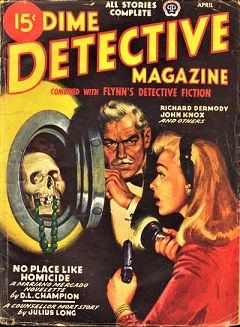
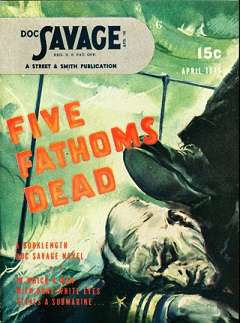
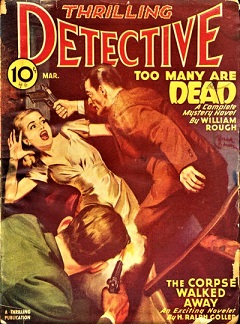
To view the entire list of weekly Old Time Radio episodes at Tangent Online, click here.